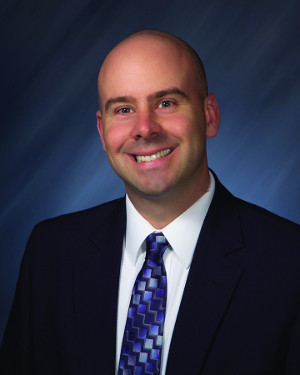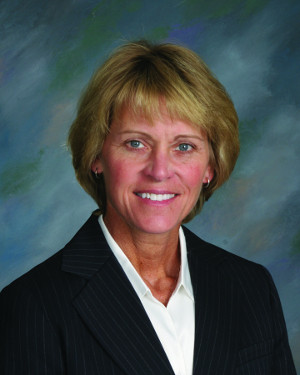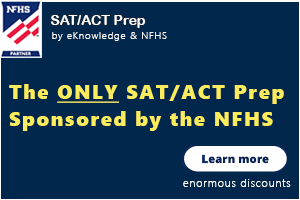Imagine that, by the first of next month, you had to justify the value of one of your school’s student activity programs to the school board in order to keep it going. Choose a program and ask yourself, “What does that program do? Why is that good?” How would you even begin to answer those questions to the school board’s satisfaction?
That is what Brian Bubach, associate director of the North Dakota High School Activities Association (NDHSAA), asked the audience at a workshop conducted in July at the NFHS Annual Summer Meeting in Boston.

Brian Bubach
Although the concept of defending school programs is nothing new, Bubach said it’s time to take a different approach to framing what is already there – through research, data collection and presentation.
“Advocating sports and activities at the state level is very important and something that most of us do on a regular basis,” Bubach said. “That said, it’s imperative that we are able to give our administrators and coaches information and tools on how to promote at the local level, where most of the decisions are going to be made.”
Using performing arts as his examples, Bubach walked through the steps of a successful proposal to gain additional resources for an existing program or promote the creation of an entirely new program. He said that qualitative analysis and data collection requires that the proposal be backed up with objective, scientific data showing why the program is beneficial for students. The soft skills that will be taught to students taking part in the program, including teamwork, decision-making and communication, should be constantly considered and demonstrated throughout the proposal.
Bubach stated that, most importantly, the packaging of the proposal should reflect the time and thought put into its creation. Try to anticipate any questions the audience may have and answer them before they are asked. See if there are any parallels that can be drawn between what is being promoted to what the principal or school board members participated in when they were in school.
“Know your audience. Know your decision-makers,” Bubach said. “When they start to reflect on their positive experiences, promotion likelihood advances incredibly.”
Bubach noted that some things in the proposal process are easy to overlook, such as determining the total cost of the new or updated program, reviewing the history of program approvals at the school or just keeping it simple, but sometimes those are the keys to success.
“If it’s a school board where there hasn’t been a lot of approval, it doesn’t necessarily mean that it’s impossible. It does mean that your promotion needs to be done very, very well in order for you to start a program or maintain a program,” Bubach said. “The more technical, the more conceptual, oftentimes equates to the more difficult to approve.”
In the end, the professional nature of the presentation may be the key to its approval. Bubach reflected on a proposal for new recording equipment he put together when he was a music teacher. After a few unsuccessful attempts, he decided to change his tactic completely.
“It wasn’t that the school board wasn’t interested in seeing music succeed; they just needed it in a format that they could understand,” he said. “We need to challenge our people to keep it pared down to that level so that everyone understands exactly what we’re looking for.”
Dr. Karissa Niehoff, executive director of the Connecticut Interscholastic Athletic Conference (CIAC), also addressed the workshop audience. She said the promotion of student activities was not only the focus of the workshop, but an underlying theme of the whole conference.

Karissa Niehoff
“Everywhere I’ve gone, there has been this idea of how do we better promote what we do to solicit support?” Niehoff said. “It’s kind of a bittersweet conversation to have. On the one hand, it’s certainly an exciting topic to talk about – advocacy for what we do in our programs – but then I think, ‘why should we have to?’”
Although state associations are well-versed in what they are promoting and why, Niehoff said that the game has changed due to an increase in outside programs and opportunities. She echoed Bubach’s thoughts that a more professional approach might be necessary.
“As educators, we’re typically not out there thinking about business strategies, but we certainly had to do that (in the CIAC),” she said. “We’re watching kids get pulled away from a very unique experience in their lives. So marketing our product, unfortunately, is something that we have to do.”
Niehoff said state association leaders should make sure their bylaws, mission statements and even logos are polished and stress the importance of education-based athletics. Inviting outside members of the community to be on their boards in an advisory role and seeking appointment to others’ boards in a similar capacity provides opportunities for updates. Simply inviting advisors to events can be helpful.
Communication is key for school and athletic program leaders, particularly with so many social media outlets available. Utilizing websites, email blasts, signs in the community, public-service announcements on the radio, apparel and ads in local print media are just some of the suggestions that Niehoff provided to the group. She stressed that all communication strategies need to be kept up-to-date, though, in order to be effective.
“If you start to let things fizzle, that will be the death of promotion. We’ve got to keep that pace, the content fresh and be very committed to a regular effort.”
Perhaps the best marketing agents are the students themselves. They love talking about what they do, so consider empowering students to become promoters. Older students can be matched with younger students, able-bodied students can be paired up with students with disabilities in Unified Sports or students can work on a community service project. The NFHS Network also offers students a prime opportunity for promoting their own programs with student broadcasting and media production.
Keeping students in the forefront of the promotion process also helps remind everyone why they are there in the first place.
“We are school people – activities were good for us, school was good for us,” Bubach said. “We need to be mindful of why school and activities are good for all kids.”
Juli Doshan
Juli Doshan is the graphic arts technician/editorial assistant in the NFHS Publications and Communications Department.
Most Recent Articles
- nfhs news NFHS Learning Center Unveils School Honor Roll Program
- NFHS Network Contact Information
- nfhs news Shout-out to Health-Care Workers and State High School Associations
- state news Stadiums Across Colorado Light Up to Show Support for Students
- gymnastics-girls article ‘They became a family’: How New Castle gymnastics qualified for state for first time since 2002



